Interview: Batwoman Takes On The Mothman in DC’s Truth & Justice
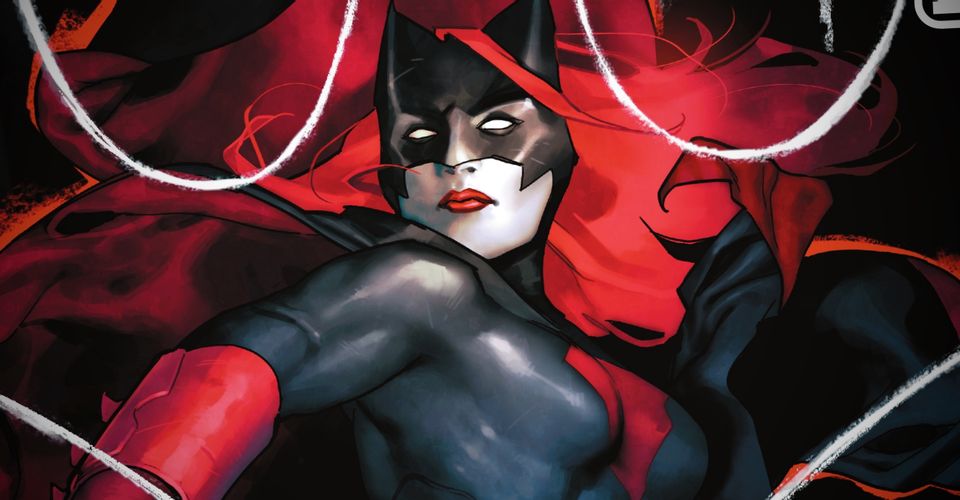
There was never any question that DC Pride would put Batwoman in the spotlight, as one of the most prominent LGBTQ+ superheroes ever created. The celebration hasn’t disappointed, delivering a twisted Batwoman tale for the ages–but Kate Kane is also leaving the city for a new kind of mystery in Truth & Justice #5.
From writer Grace Ellis (Lumberjanes), with art by Maria Laura Sanapo and Wendy Broome, the story sends Batwoman away from her usual stomping grounds and supervillains for a break in the countryside. But as is always the case with DC’s heroes, an attempt to take time off just leads to a change of scenery, but the same brand of heroics. For Batwoman, a new challenge arises in the form of the Mothman–yes, the cryptid–and a surprising twist (or two). Screen Rant got the chance to speak with Ellis about this special story, blending a member of the Batman family with North American cryptid lore, and the true threat at work in this mystery: Appalachian bartenders. Readers can enjoy the full interview and preview of the tale from Truth & Justice #5 embedded below.
Screen Rant: You’ve crafted a story about Batwoman crossing paths with the Mothman. I realize this might be a very silly question to ask the writer of Lumberjanes, but what makes cryptids so appealing to you, and so versatile a touchstone?
Grace Ellis: When they put this interview on my calendar, I was like, “I bet he’s going to ask about cryptids.” I’m excited that you did, but despite the fact that I just said that, I actually don’t have a good answer for you. It’s just something deep in my psyche that’s like, “You know what’s really fun? It’s a monster, and we’ve seen it, but we don’t know for sure that it exists.” I don’t know, I love the local-ness of something like Mothman. I think it’s really cool, and very binding for a community.
I also think that I really like the dual nature of it. That’s a big thing in Lumberjanes, and… now I feel like I’m talking to my therapist. You see one thing, but it’s really something else secretly. That’s something that keeps coming up over and over my work, but it’s not intentional at all. Is it the ego? The super ego? The id? One of those is just leaping out of me when it comes to cryptids.
Maybe on some level, it’s because cryptids could be real. They’re not, but part of me is like, “This could potentially already exist in the real world.” You wouldn’t have to explain a microwave in a Batwoman story in the same way, because we already know about that. It feels like part of the world already. And Batwoman is such a lush world, anyway. She’s got a long history with fables and stuff, so it seemed like it made sense.
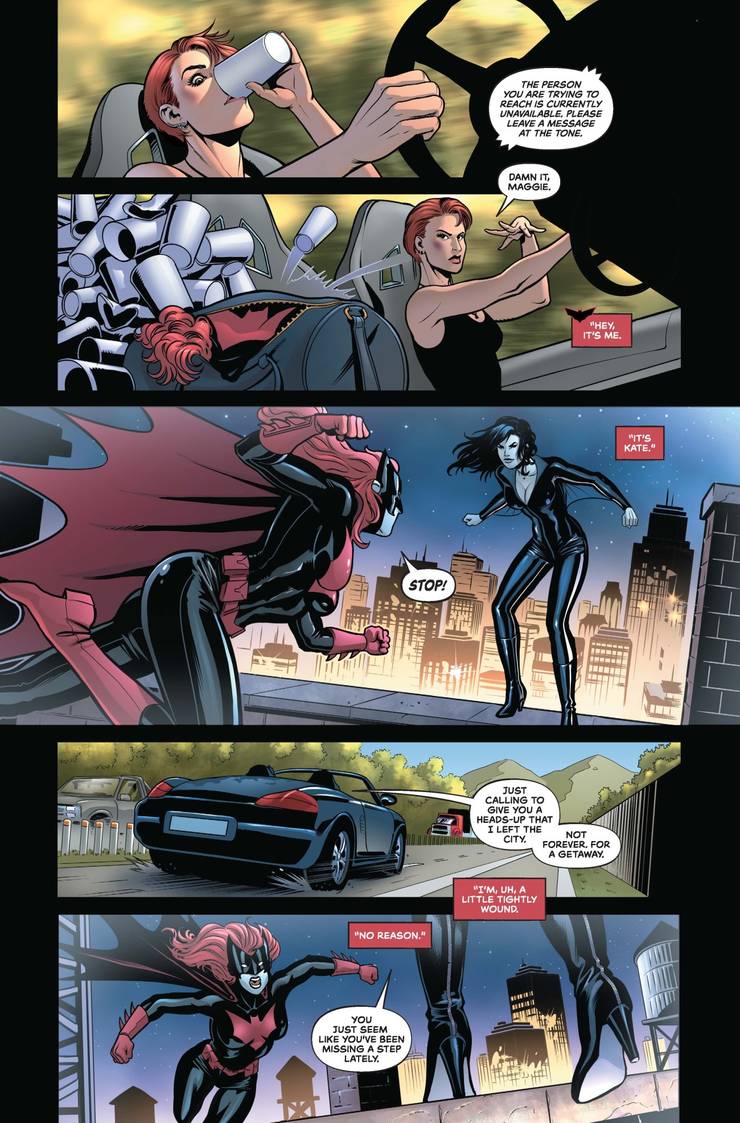
SR: Is there a reason for choosing the Mothman in this story? I realized, as you were describing the Mothman, that you’re basically describing a member of the Batman family.
Grace Ellis: Yes! I think it was just a happy coincidence, because when I was approaching the story, I was thinking about superhero conventions. It’s not a long story, so you don’t have a lot of runway to build a whole world about Batwoman. I was like, “What is it about Batwoman that makes her Batwoman?”
She’s very similar to Batman; she’s functionally very similar, but doesn’t necessarily have the same ties to Gotham that Batman does. So I was like, “Okay, what if we took her out of the city and put her in a completely different environment that she’s not familiar with?” Maybe she would be on her back foot a little more, and we could do some things with that and extrapolate it out from there.
What are some cryptids that I like, that are in areas that I know? And we ended up in Appalachia. Because I live in Ohio, which is not Appalachia – I’m not in that part of Ohio – but I’ve been there enough, and I’m familiar enough with the whole scene that I knew I could do it. That’s how we ended up with that. Also, I love Mothman. Who doesn’t?
SR: I think that Kate is so often positioned as a foil to Batman. Was it possible to craft a Batwoman story without having Batman in mind? And is that necessarily a bad thing?
Grace Ellis: Well, I don’t think that you can pull them apart all the way. I think that Batman is always going to be part of Batwoman’s story, because she didn’t spring up fully formed without him. Unlike how Superman did; you can have a Superman story without any details.
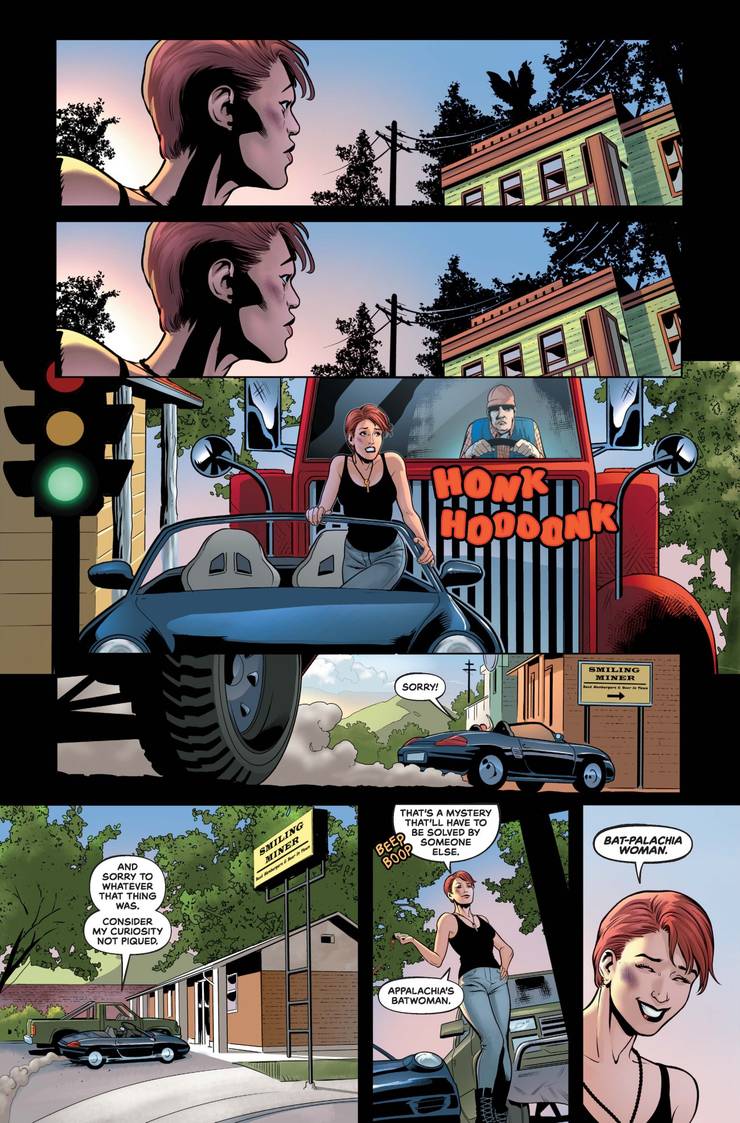
Man, that’s a tough question. Honestly, I think the best thing to do if you want to write a Batwoman story without Batman is to just not include Batman at all. This story doesn’t mention Batman at all. I haven’t seen the TV show, but my understanding is that on the TV show, Batman is out of town or something. And that’s really frustrating to me, because just do it without him.
It’s definitely possible if you just plow ahead without him. The dynamic between Bruce and Kate is interesting, and I don’t know that that’s something you want to leave out completely. But if you did, I think you just do it and don’t mention it. Gotham is a big city.
SR: Kate’s reputation precedes her, but the story begins in a place that you’d never expect: she’s realizing that she needs time off. That feels like a very deliberate way to depict her character. What led to that?
Grace Ellis: I’m feeling overwhelmed myself, I think. Everybody’s got to take some time off now. And here’s the thing: I don’t come from a superhero background – obviously, you mentioned Lumberjanes, and you know this. When I was thinking about writing for a superhero, I’ve always been more drawn to the non-super elements. I like writing the fights, and I like all of that. But I prefer the personality stuff and the day-to-day stuff.
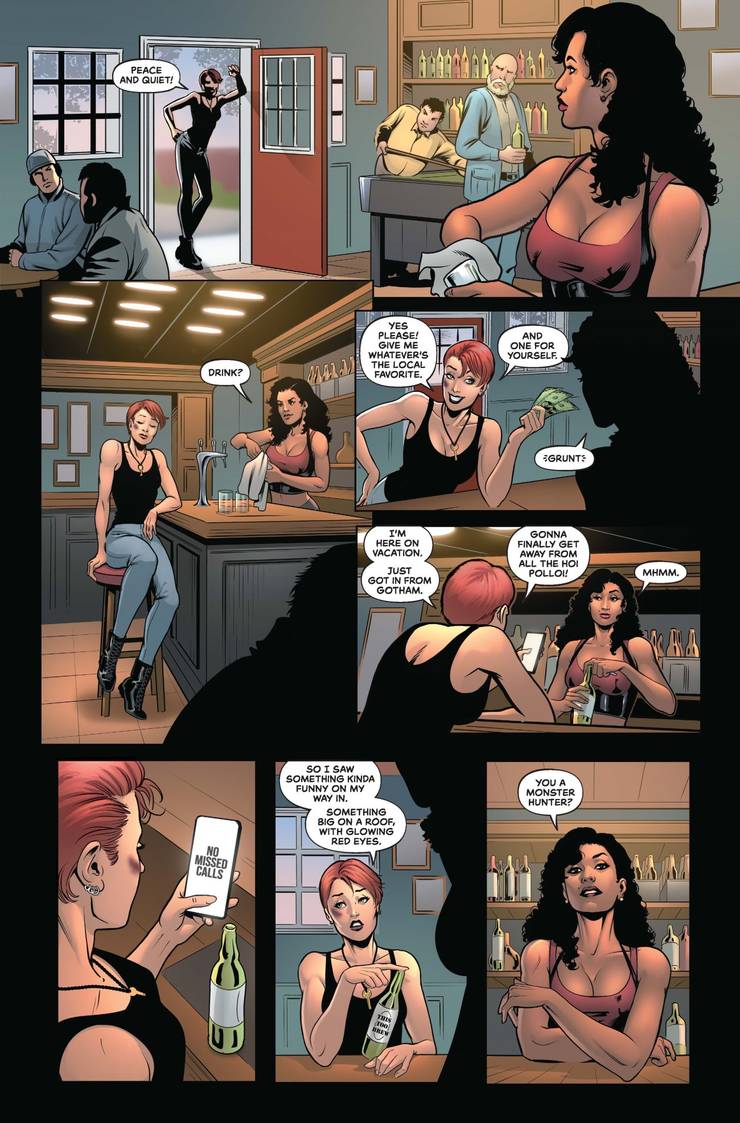
Honestly, if there were a comic that was just, “This is what’s happening at the Daily Planet, and there is nothing super about it,” and it would just be an intern getting coffee for 22 pages. Yes, more of that! I would be the only person to read it, but I would love it. Reading all the spreadsheets, like, “Oh, okay. I see that in the third quarter here, we’ve dipped down a little. That’s interesting. What does that say about these characters?”
When I was thinking about Batwoman, I was thinking about her as a person primarily; a person who happens to also fight crime. And I was thinking about how, if I were fighting crime – and I was fighting crime all the time – I’d feel this giant weight of responsibility all the time. Imagine you take the night off, and a crime happens. That’s on you; you took the night off. Shouldering that burden all the time has gotta be tough. You’ve got to get out of the city every once in a while.
SR: Most people expect to pick up a superhero comic and find so much baggage. But in this story, what you are walking into is completely personal relationships with Kate and Maggie. If someone is not familiar with Batwoman’s relationships, that’s what they would be having to piece together. Was that also a deliberate choice, not to offer much exposition?
Grace Ellis: I think that I want to give the reader just enough information. I think this is the tind of thing you can pick up if you haven’t read any other Batwoman, for sure. I’ll be honest, I haven’t read a ton of Batwoman; I was doing a lot of Googling. There’s just there’s a lot of it.
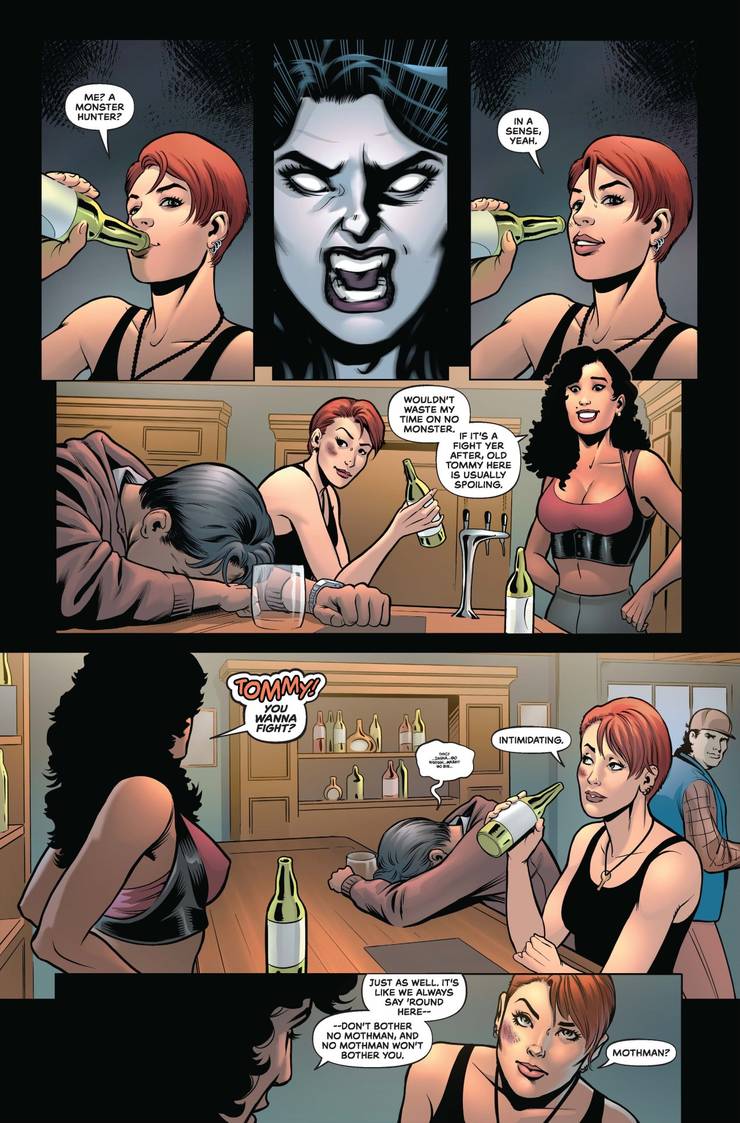
I think that if you’re new to Batwoman, this is actually a good place to start. Because she’s been through a lot, and her relationship with Maggie is – I mean, “fraught” would be putting it mildly. Some of the stuff she went through is wild. So, I think that instead of trying to pack it all in, you’re just being like, “It is what it is.” They are on rough terrain, and that is all you need to know. We’re just going from there, without trying to overexplain every emotion. Sometimes it sings a little better, so to speak.
SR: This story takes some twists and turns, but my favorite is how the typically confident and determined Kate is completely thrown by this Appalachian barmaid. That may be largely due to how she’s drawn from the first panel, but what can you say about your goal with that dynamic?
Grace Ellis: I should say that, when you’re writing a comic, one of the things I like to do is leave space for the artists to fill in some gaps. One of those spaces that I left was describing the barmaid. I didn’t at all; I just said grizzled and tough.
This was not at all what I was picturing, but I really like it. Because it’s so different. Kate is so used to being that type of person. She just has all the information and is just gonna plow ahead. So, the fact that there is now this other character who is in that position while Kate is overwhelmed in a new environment and trying not to be; I think it worked really well. I mean, the art in the whole book is great. It was a happy surprise. I really liked it.
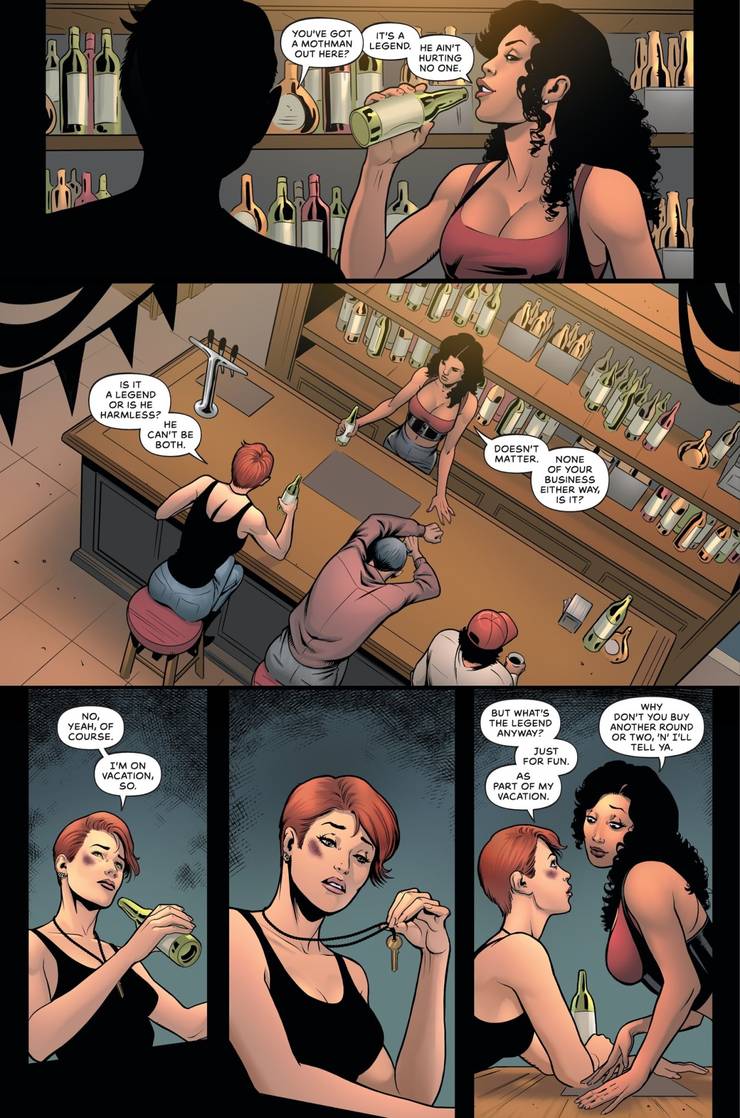
SR: I love that choice and that dynamic, because as soon as Kate walks into that bar, it’s a question of when subtext becomes text. This is a story during Pride month that is about the most visible LGBTQ hero at DC and probably the most famous. Does your process change in response to that pressure?
Grace Ellis: When I’m writing, I don’t think about that at all. I just write the story that I want to write. And the stories that I write have gay characters in them, usually. I mean, they asked me to write a Batwoman story, so that’s what you’re going to get.
But there is a lot of pressure for every depiction of an LGBTQ person to be the definitive one that checks boxes for every person – and that’s just not possible. I think that when you’re writing any minority character, you just have to do your best to make them a full person. You make sure that it’s part of the story; that they are just a person going about their lives. Because we all are.
This comes up time and time again. I think it’s just something that, culturally, we’re all going to have to deal with. Not you; this is for LGBTQ people specifically, who are very wrapped up in needing every depiction to be perfect in very particular ways. They’re just people; they’re gonna make mistakes and have weird moments with lusty bartenders.
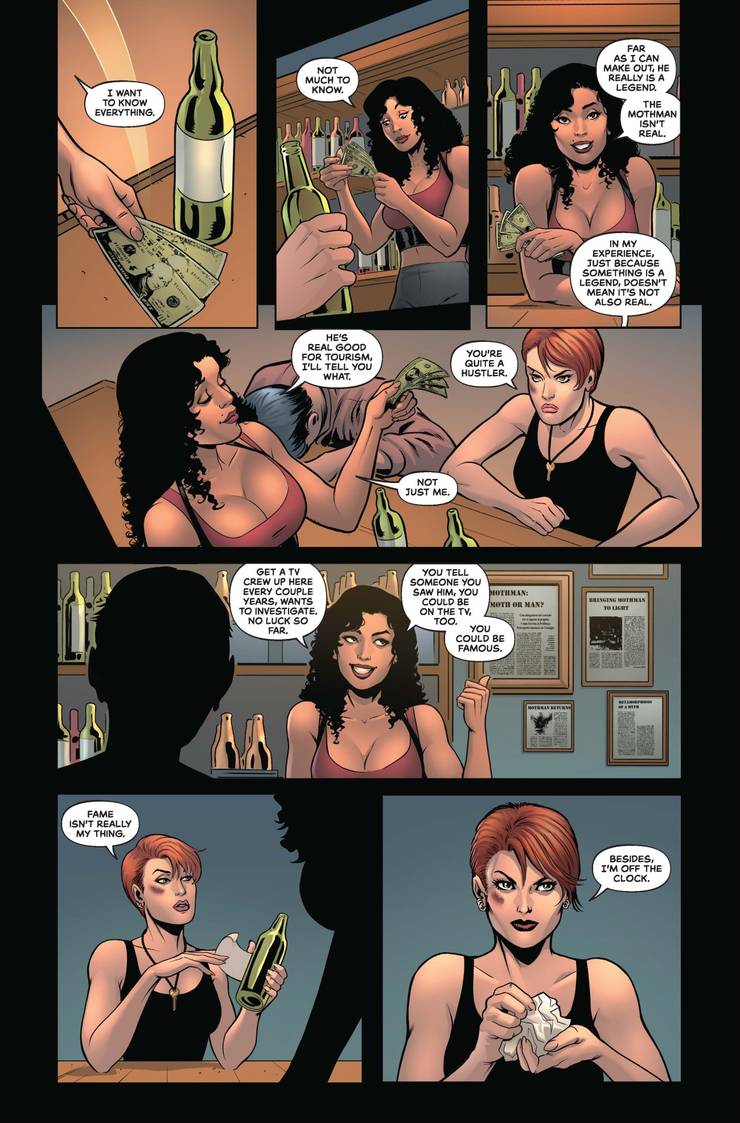
SR: What stood out is the casualness in this story. Someone who is unaware of the sexual history of Batwoman might miss it, but for those of us who are aware, in my case, the story is screaming that representation is happening here. It feels more casual in the way that it occurs in this story, but incredibly powerful.
Grace Ellis: Oh, good. I’m glad that it worked. Here’s the thing. I think that there are basically two tracks you can take: you can either have a story that is like a coming out story talking about gay issues, or you take the other track, which is just everyday life with [sexuality] as background noise. And we need both of those things, for sure.
In terms of what counts as good representation? The answer is both. But I like the casual ones. I think that they feel more relevant to me, personally. That’s completely just about me, and I know that there are other people who need the other kind. And I think that’s totally fine, too.
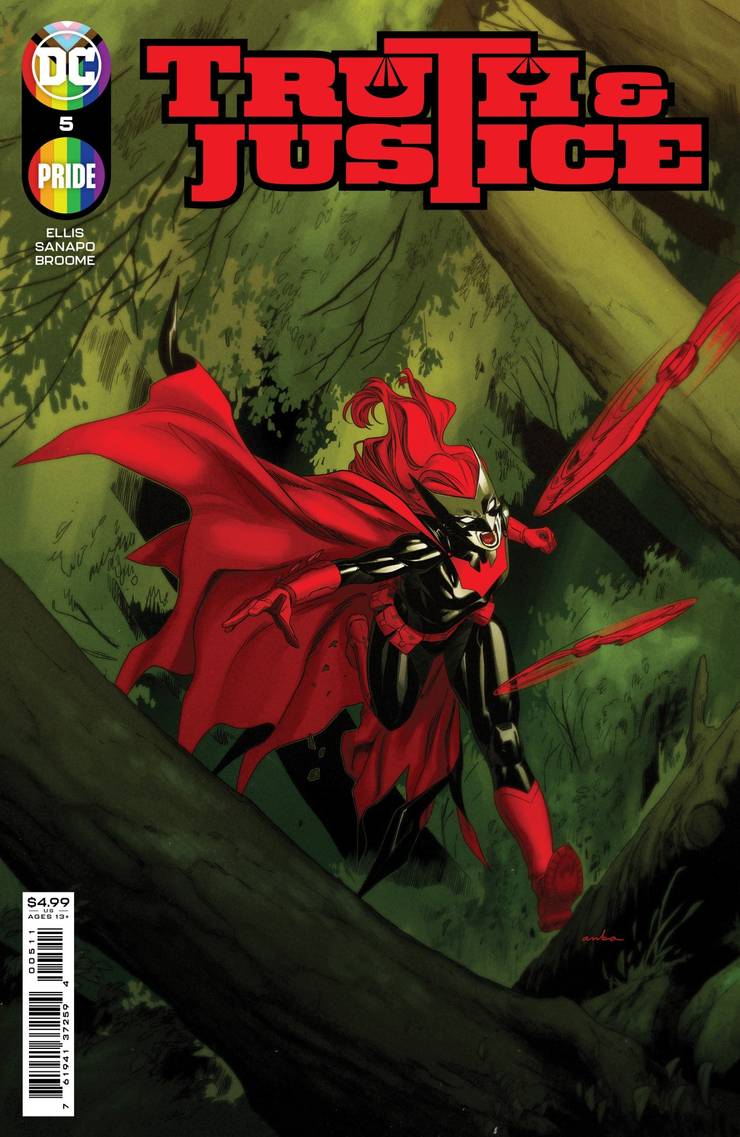
SR: Now that you’ve gotten to do a full-blown superhero story, does it feel like you’ve scratched an itch, or like you could do a lot more of this?
Grace Ellis: I think that this has awakened something in me. And I’m like, “Okay, let’s write more superheroes. Let’s do it.” I have so many ideas. I’m ready.
SR: How many of them are about cryptids?
Grace Ellis: No comment.
Truth & Justice #5 is available now wherever comic books are sold, physically or digitally, from DC Comics.
About The Author


















